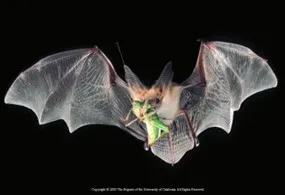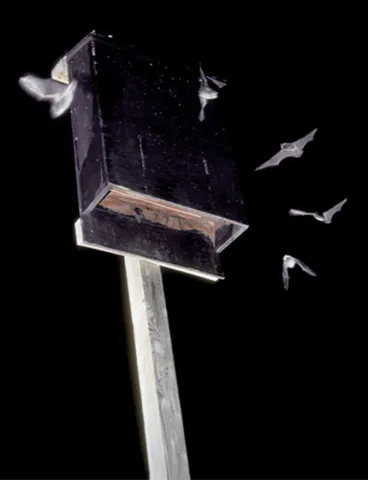By Mike Zigelman, UC Master Gardener
Benefits of Bats Bats are a primary predator of night flying insects and many insect pests. One little brown myotis bat can catch a thousand mosquitoes an hour. A colony of 150 brown bats can eat enough cucumber beetles to prevent egg laying that would give rise to 33 million root worms. |  A pallid bat catching dinner mid-air. Credit: Bat Conservation International |
 Little brown myotis using a bat house Credit: Mark and Selena Kiser | Bat House Specifics
|
- Bats like dry, warm, dark, non-drafty houses with ventilation.
- Use only water or latex based paints and stains and avoid pressure treated wood.
- Bats generally prefer their housed mounted on poles or building walls rather than in trees. Houses mounted under the eaves of buildings but still exposed to the sun tend to attract the highest occupancy. Mounting on the side of a building or a pole tends to protect the bats from predators. A height of 12-20 feet is preferred or at least above the highest growing vegetation found below the house.
- The lower part of the houses should contain a landing area. Note that both the landing area and the back wall leading up into the house is either scored with a saw blade and/or covered with heavy duty plastic netting of the type used to screen rain gutters. This provides traction for the bats to land, climb and move around inside the house. The interior of the houses is stained black with a water-based stain to make the house dark and cozy.
- Bat occupancy rates tend to be the highest when houses are located as follows:
- On buildings or poles
- In rural rather than urban areas
- Dominant land use in a one-mile radius is natural vegetation, closely followed by farm land
- Dominant agricultural use within a one mile radius = orchard or alternatively mixed use orchard/row crop/pasture
- Nearest freshwater source a lake larger than 25 acres.
References
Design of the bat houses based on plans found in The Bat House Builders Handbook.
Data for this sheet also taken from The Bat House Builders Handbook by Merlin Tuttle, Mark Kiser, and Selena Kiser, published by Bat Conservation International, PO Box 163603, Austin, TX 78716, and distributed by the University of Texas Press. www.batcon.org
